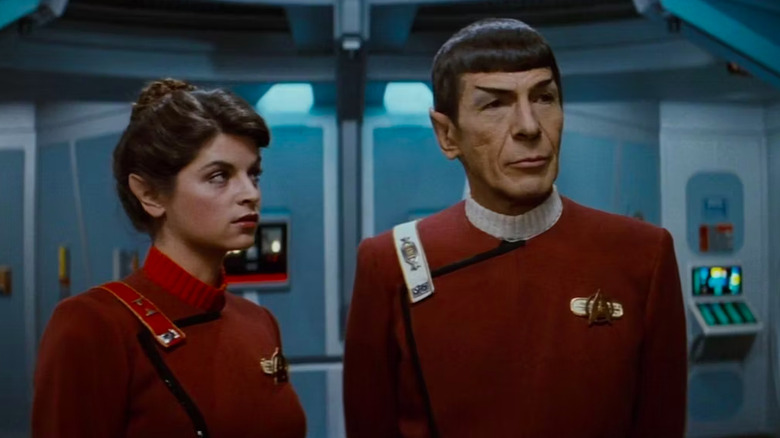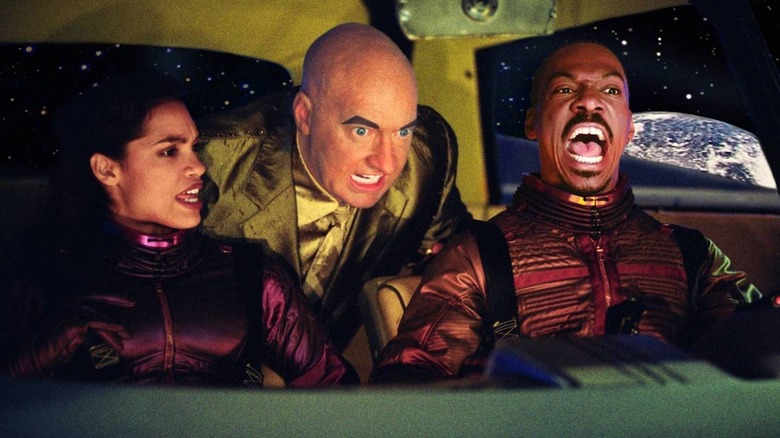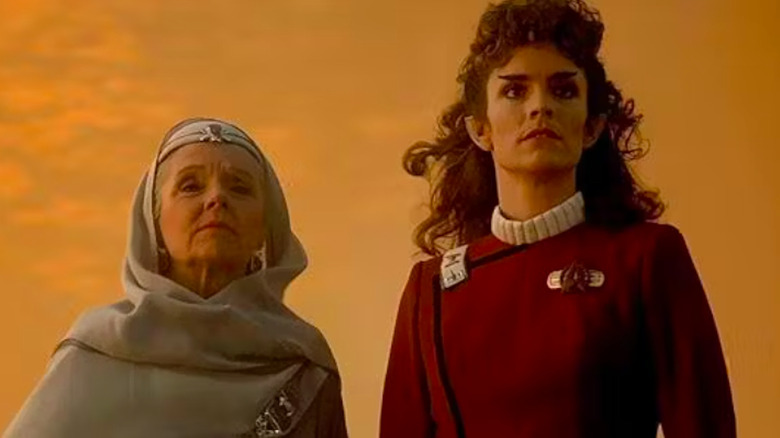Five Cut Lines Completely Changed The Ending Of Star Trek IV: The Voyage Home
The "Star Trek" franchise was nearing a crossroads in 1986. 20 years after the premiere of The Original Series on NBC, moviegoers were showing up in significant numbers to follow the big-screen exploits of Captain Kirk and the crew of the Starship Enterprise. But while 1982's "Star Trek II: The Wrath of Khan" and 1984's "Star Trek III: The Search for Spock" were hits for Paramount (they both grossed in the $78 million range domestically), they were not blockbusters. So when stars William Shatner and Leonard Nimoy asked for salary bumps, the studio had some tough decisions to make.
Paramount almost received an unexpected windfall when their under-contract box office juggernaut, Eddie Murphy, asked to be in the fourth "Star Trek" movie. Murphy had just starred in "Beverly Hills Cop," the highest-grossing movie of 1984, and, as a hardcore Trekker, wanted to be a part of Gene Roddenberry's sci-fi universe. The studio was thrilled, and Nimoy, who was set to direct the film, understood the commercial potential of Murphy's involvement. This could massively expand the Trek fanbase, with Murphy being the rising tide that lifts all ships salary-wise.
So Paramount hired the screenwriting duo of Steve Meerson and Peter Krikes to write the first draft of what would become "Star Trek IV: The Voyage Home." The film would bring Kirk and company from the 23rd century to the 21st, where their quest to bring two humpback whales back to the future would receive assistance from an uber-nerdy college professor played by Murphy. This obviously did not come to pass, but the writers, emboldened by Paramount's eagerness to take big narrative swings, almost complicated Spock's life in a fascinating way.
The De-Murphy-cation of Star Trek IV
Speaking to Edward Gross and Mark A. Altman for their book "The Fifty-Year Mission: The Complete, Uncensored, Unauthorized Oral History of Star Trek: The First 25 Years," Krikes and Meerson revealed that Murphy's role was essentially turned into Catherine Hicks' marine biologist Dr. Gillian Taylor. Per Krikes:
"If you look at our script and the movie you saw, basically everything is still there, like Eddie Murphy going to meet the aliens in the park to bring them gifts, and he runs into the invisible ship ... which is what Catherine Hicks did when she ran into the park to find Kirk. The structure really is exactly the same."
The rewrites were handled by Nicholas Meyer (who arguably saved the franchise with "Star Trek II: The Wrath of Khan") and Harve Bennett. Meyer claims he never read the Meerson-Krikes draft, which rankles Krikes, who is adamant that many of the film's fun elements — Taylor getting beamed aboard the Bird of Prey and Spock nerve-pinching the surly punk on the city bus — existed in their version of the script. As he told Gross and Altman, "You can't imagine the frustration of them trying to take all the credit for something that was completely blocked out for them. Plus, they removed a lot of the emotional qualities that we thought it would have."
One of those qualities would have altered the course of the Trek film franchise in a major way.
Saavik should've played a bigger role in the Trek universe
Beginning with "Star Trek II: The Wrath of Khan," the Vulcan character Saavik emerged as an intriguing component of the franchise's ever-expanding universe. Played initially by Kirstie Alley, and then, in the next two films, by Robin Curtis, her path seemed destined to merge with Spock's. Leaving aside the Eddie Murphy of it all, the biggest departure from Meerson and Krikes' screenplay was the omission of an exchange between Kirk and Saavik. According to Krikes:
"There was a scene with Kirk on the bridge of the Bird of Prey. They cut out five lines where Kirk says to Saavik, 'Have you told him yet?' And she says, 'No. I'm taking a maternity leave.'"
That would've been a bombshell development in Trekland. "That's why she's standing with Amanda [Grayson, Spock's human mother] when the Bird of Prey leaves," said Meerson. "Because Amanda knows Saavik is carrying Spock's kid. All they did was cut out five lines of dialogue, and you lost that whole thing."
Had Nimoy, Meyer, and Bennett kept that moment, "Star Trek V: The Final Frontier" would be a completely different (and possibly good) movie. I think we still get "Star Trek VI: The Undiscovered Country" because Kirk's blood feud with the Klingons had to get resolved, but Spock would've had more to do than hang out on the Enterprise while Kirk and McCoy are subjected to a show trial.
The biggest bummer here is how Saavik was unceremoniously written out of the Trek narrative. I'm not sure making her the mother of Spock's child was the most interesting direction in which to take the character, but I do wish we could've gotten more of her in the official canon. And I'm still waiting for Murphy to make his triumphant "Star Trek" debut as a member of the Jenkins clan from Vulcan.


